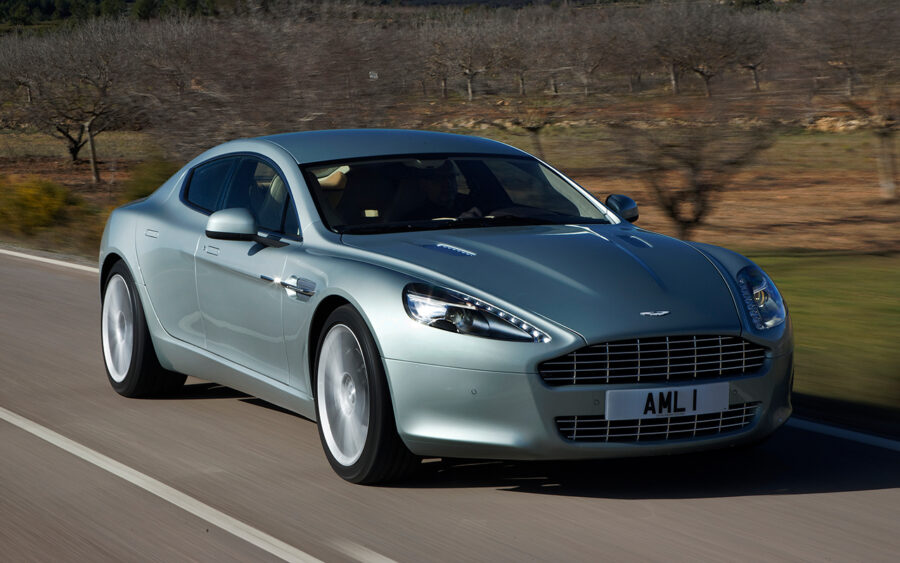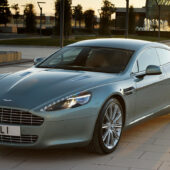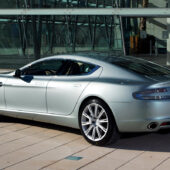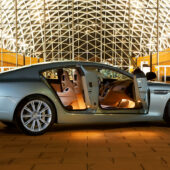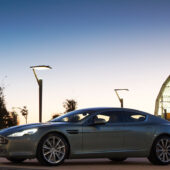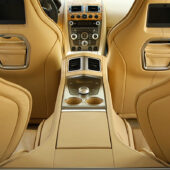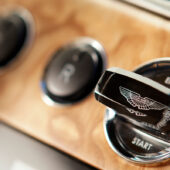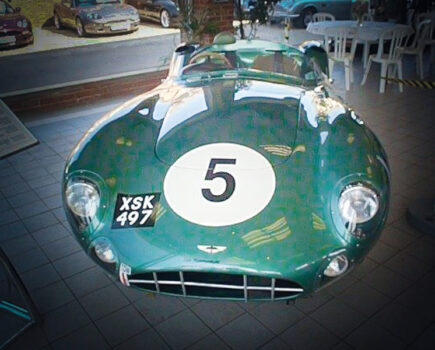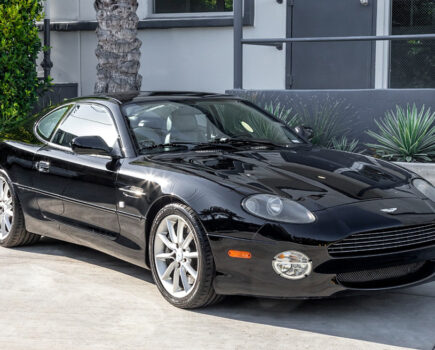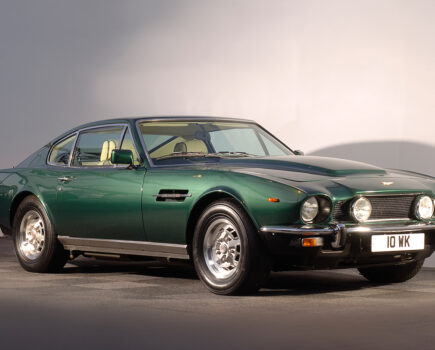The Aston Martin Rapide was a glorious high performance saloon that struggled in a market that had largely shifted to luxurious big-power SUVs. Here’s how to buy one today
Words: Kyle Fortune
A genunine example of a four-door sports car, the Rapide was and remains one of Aston Martin’s most impressive cars. Yet despite its fine attributes and only going off sale recently, the Rapide has largely been forgotten by the market. This was also true during when the Rapide was new; it was arguably the wrong product at the wrong time in 2010 as fast saloons were superseded by big-engined premium SUVs. With more height and greater space added into the more traditional fast, four-door genre, you only need to look at what Aston Martin itself has replaced the Rapide with – the Aston Martin DBX – to see what most customers in this sector want.
For many that’s a little difficult to stomach because the Rapide is a fantastic car which transcends thoughts of practicality and space – neither of which are in abundance – and instead embodies something that perhaps an Aston Martin should be: a car that’s extraordinary not just in its beauty and performance, but something beyond the rational. However, economic realities meant that even at launch the Rapide was pretty much doomed to fail as a viable, decent-volume and profitable revenue stream for Aston Martin.
Rivals did things a bit differently. The Bentley Continental Flying Spur was the benchmark for quick luxury, while the Porsche Panamera was more spacious and just as quick in its highest-performance iterations. Others like the Maserati Quattroporte and Mercedes-AMG CLS were able to offer much the same formula at a lower price point. The fact that the majority of the Rapide’s then-competition have also gone off sale underlines just how the market it competed in has dwindled as fashions have changed.
The economic environment the Aston Martin Rapide arrived in didn’t help its cause. It arrived just in time for a global recession – not ideal for a £140,000-plus luxury saloon. The earliest cars will now cost you around a quarter of that, however – a very tempting proposition indeed.
Originally hinted in concept form at as far back as 2006 at the North American Auto Show, it would take until 2009 for Aston Martin to reveal its production model. It did so at the Frankfurt Auto Show, where the company also added Aston Martin badging, instead of the concept’s Lagonda branding. The Rapide name stuck, as did the five-door fastback layout, the Rapide only ever offered in this body shape, though Bertone did make a one-off shooting brake (estate) model named Jet 2.
Unsurprisingly, the Rapide borrows heavily from the DB9, using a version of its VH bonded aluminium structure, as well as a development of its 5.9-litre V12 engine. The V12 delivered 477hp and 600Nm of torque, enough to propel it to 100km in around 5.2 seconds, it driving its rear wheels via a six-speed Touchtronic II automatic transmission. Visually, there’s a clear familial link to the DB9, though the lengthened rear, with its two doors neatly integrated behind the front ones. Those rear doors are relatively small, making getting in and out a bit tricky, as does the fact the seats they access aren’t particularly accommodating, either. An occasional family car, then, opposed to a car you’ll use daily, or want to be driven in.
The first cars weren’t built in Aston Martin’s Gaydon facility; instead a line was built at the Magna Steyr production plant in Graz, Austria, a company that specialises in contract car-building for a variety of manufacturers. Some commented at the car’s launch that as a result of this, the Rapide was Aston Martin’s best-built car, and certainly the launch cars did feel particularly well constructed – something that’s not always true of Aston’s earliest efforts. Production moved back to the UK in 2012 after the Rapide failed to meet its anticipated sales targets of around 2000 cars a year.
It wouldn’t take long for Aston Martin to revise the Rapide, with the Rapide S taking over in 2013 and running until 2018. It, as is the way with these things, upped power for a greater top speed and a sub-five-second 0–62mph time. It benefitted from a new front grille and a more pronounced lip on the rear boot lid. The early S made do with the six-speed automatic but from 2015 came with a Touchtronic III automatic transmission with eight ratios, which dropped that 0–62mph time even further, and pushed top speed to 203mph. The final Rapide was the AMR, built in a series of just 210 examples and fitted with a V12 now pushing out 603hp. Standard kit included standard carbon ceramic brakes situated behind 21-inch alloy wheels.
Around the same time the last AMRs were being built, Aston Martin revealed an electrically powered Rapide, the Rapide E, with 155 examples due to be produced. Aston Martin shelved this project very close to its intended launch, the company instead describing the model as an experimental machine. It wasn’t the only experimental Rapide: a racing version competed in the Nurburgring 24hr race using a hybrid-hydrogen combustion engine that could use petrol or hydrogen, either on their own or at the same time.
The Rapide was quietly dropped in 2020 having never reached its proposed sales numbers, although Aston Martin did underline that there’s still a small, if very exclusive and wealthy, set of customers for whom a luxury four-door model appealed during 2015 and 2016. The Rapide formed much of the structure for the Lagonda Taraf, a bespoke model built in a series of just 120 cars – although even it demonstrated the limited market, as the initial plan was for 200 – for a cost of around £1 million.
The Aston Martin Rapide was already a car trailing its competition in the driver assistance technology and convenience departments when it was launched, so was feeling seriously outdated by 2020. Still, it remains beautiful today and now as a used buy it’s more appealing than ever.

Bodywork
It won’t come as a surprise if you’ve perused our buyer’s guides on other Aston Martin models that the Rapide is built from aluminium, which means it does suffer some of the same corrosion issues that you’ll find in the DB9 and V12 Vanquish. Check the paintwork for any bubbling; this points to corrosion that’s a result of water getting beneath the paint or areas where different metal types meet. Areas where this might occur are around the vents in the front wings, the wing mirror mounts, the door bottoms and indeed anywhere on the bodywork, so have a close look for any signs of bubbling paint.
While it’s a known issue with the DB9, it seems that the Aston Martin Rapide suffers less from corrosion – perhaps thanks to higher-quality manufacturing – although as the car ages it’s inevitable that some sort of corrosion will occur. It’s best fixed early to keep the costs manageable.
Engine and transmission
Like its bodywork, the Aston Martin Rapide’s engine is largely shared with the DB9, so it’s not surprising to find it featuring some of the same issues as in its two-doored installation. As with any Aston Martin, expectations for reliability centre around a history of correct, timely servicing; most are likely to still have a fully-stamped Aston Martin main dealer service booklet, so look out for this. Don’t rule out cars that have been worked on my recognised specialists, as they typically see older cars more often than Aston Martin main dealers and are often better at detecting issues and dealing with them more cost-effectively.
Even though the Aston Martin Rapide’s 5.9-litre engine is basically that of the DB9, it doesn’t seem to suffer quite as many issues as that car; perhaps a result of owners not having thrashed it quite so hard. The Rapide impressively able when pushed but more realistically a car that’ll spend less of its life being leaned on than a DB9. Even so, we’d look out for all the DB9’s issues when looking at a Rapide: check the air filters and their housings for oil, which gathers there and is dropped into the intake system as a result of failed PCV breather valves.
Independent Aston Martin specialist McGurk Performance Cars says to listen out for any ticking on cold start or a knocking noise – these point to internal wear and requiring a costly re-build. McGurk suggest if a re-build is in order you’re as well buying a complete engine from Aston Martin because it’ll cost about the same as remedial work, comes with a warranty and is bench-tested before it’s sent out. Check the exhaust is in good shape, and in particular the catalytic convertors – a very expensive part to replace.
The gearboxes, either the earlier six-speed or later eight-speed are robust, but check they’ve had replacement oil in them, and continue to do so as part of your regular service schedule.
As with any high-performance engine prevention is better than cure, so keep a check on all fluid levels and check all the seals for leaks. The differential and crown wheel, related to the DB9 again, can begin to fail and the propshaft can go out of balance; all these faults will be obvious, with vibrations and graunching sounds pointing to issues. There were a few recalls in relation to the automatic transmissions, including difficulties engaging park or going into neutral, although these should have been sorted by Aston Martin. A quick check with the car’s VIN number at a dealer should ascertain whether the recall work’s been done.

Suspension, steering and brakes
Like the rest of the Rapide, the suspension is pretty much lifted from the DB9 so the same issues will occur – only with the Rapide weighing more, expect things to wear a little bit quicker. This depends on usage but the Rapide takes a bit more stopping, and comes fitted with larger front brakes than the DB9, while the later AMR model gets carbon ceramic discs as standard. The brakes, with the exception of those carbon ceramics, aren’t punitively expensive to replace and should last comfortably in excess of 15,000 miles unless you live at the top of an Alpine pass or have a peculiarly heavy foot.
The suspension is a double-wishbone setup with adaptive dampers. The dampers can leak and aren’t cheap to repair, so check that they’re not doing so, and check the different settings for the suspension actually make a difference on any test drive. Check the state of the tyres, and the brand; if they’re worn unevenly it points to alignment issues, while any sign of previous owners skimping on tyres should leave you wondering where else maintenance shortcuts have been taken.
Interior and trim
The interior is fairly well-proven but a good number of the switches and stalks are sourced from cheaper manufacturers, so shop around if you find anything not working perfectly. Check the windows are working properly as water ingress can affect their operation – they should all also drop when you open the door, closing automatically to help create a good contact with the rubber seal on the frameless doors. Those doors, like all modern Aston Martins, open in a swan-wing fashion (that’s to say out and up a bit) which helps clear higher kerbs and also adds a bit of theatre into getting in and out.
The interior should wear pretty well and it’s likely that in most the rear seats will have barely been used. Interestingly, the two rear seat backs fold at the touch of a button (check this works) to increase the loading volume from 317 litres to 886 litres. All in, the Rapide’s interior has all the hand-finished appeal and charm of any modern-era Aston Martin, that’s refreshingly devoid of the digital, feeling like an analogue car on every level.

Verdict
A wonderful car to look at and drive, the Rapide’s appeal when new was limited thanks to its lofty price and the loftier spread of ability of its high performance, premium manufacturer alternatives. Aston Martin described it as a four-door sports car and that’s more than marketing babble, because it really is. A special car that oddly doesn’t seem to suffer the issues of other Aston Martins of the same era, the Aston Martin Rapide is a real favourite here.
Find a good one, keep it that way and you’ll have a very special and unusual car that’s got style in abundance – and those looks are backed up with real driver appeal, too.

